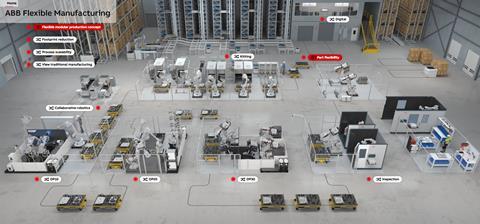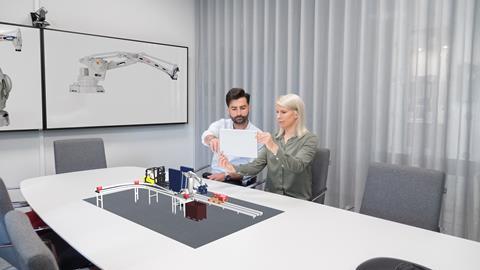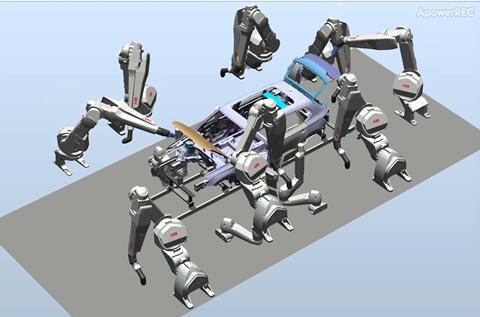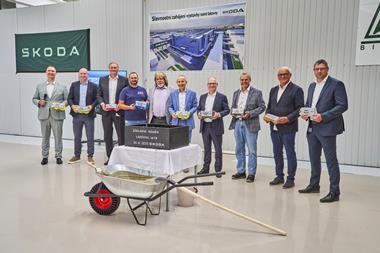The need for greater flexibility in automotive manufacturing is already influencing investment decisions within OEMs but also has major implications for the supply chain. Automotive Manufacturing Solutions (AMS) spoke to Tanja Vainio, Managing Director, Business Line Automotive Tier 1, Robotics and Discrete Automation Business at ABB about the challenges ahead and the available solutions.

Why has ABB created a Robotics and Discrete Automation Business Line specifically dealing with Tier One suppliers?
As the automotive industry transitions to electric propulsion, it faces major uncertainty over consumer demand for the alternative powertrains. Product mix and manufacturing volumes are likely to fluctuate severely as demand levels vary unpredictably between IC engine, hybrid and electric vehicles, based on developments in EV range, battery costs, government legislation and purchase incentives. The environment is changing so fast that the preferred solution today may not be the ideal one for the future. The situation is aggravated by variations between different regional markets.
OEMs are moving quickly from established production methods that are dedicated and inflexible, to a cell-based approach which offers greater flexibility. Tier One suppliers are being impacted too, as their OEM customers now demand faster responses to variations in product mix, which is driving a fundamental review of manufacturing processes. In order to provide focused and dedicated support to the specific needs of the supply chain, ABB has set up the new division.
What are the key challenges facing the automotive supply chain?

They are not only being challenged by their customers to adapt to increasing product variety and fluctuating volumes, but are being tasked with adjusting to the changes more rapidly than ever before.
Supplier expertise tends to be concentrated in particular product technologies and manufacturing processes so the only way to develop solutions quickly enough is through collaboration with a suitable external partner. There is much more variation between suppliers than between OEMs. For example, the component size ranges from small switches to cast metal body structures; individual factories are often smaller but there may be many of them; there is a wide variety of automation applications, such as painting, textiles, sewing, electronics, welding and wiring.
Combining the process expertise of the supplier with the automation and robotics expertise of a company like ABB enables co-creation of automation solutions in which products are not only ‘designed for manufacture’ but ‘designed for automation’. It’s not just a matter of buying some robots; it’s taking a completely fresh view of how to maximize manufacturing efficiency in an uncertain and rapidly changing environment. This is achieved most effectively by involving the automation partner at the earliest possible stage of planning to secure the greatest competitive advantage.
“A truly flexible facility can accommodate not only changes in volume and product mix but also changes in operations and sequence, as new propulsion technologies emerge” – Tanja Vainio
Why is automation the answer?
Conventional ‘long line’ assembly bolted to the floor and with dedicated jigs and fixtures can only produce defined products and is badly disrupted by changes. The industry is seeking ‘zero loss’ re-tools, whereby a line can be re-tooled for a product change without any loss of production. Additionally, traditional conveyors and manual materials handling are being replaced by AGVs. So, a truly flexible facility can accommodate not only changes in volume and product mix but also changes in operations and sequence, as new propulsion technologies emerge.
ABB’s approach is based on modular, scalable manufacturing cells which minimise cost and risk by reducing the unknowns involved with changing the manufacturing sequence or volumes. Unlike fixed lines, flexible cells can be re-purposed to produce different parts in different volumes, adding identical cells where required. Users can even take advantage of ‘lift and shift’, whereby existing cells can be relocated anywhere in the world to meet regional variations in demand, operated using the same programs, user interfaces and HMI, and delivering consistent standards of quality and output.
Sustainability is an increasingly important criterion for OEMs when choosing suppliers as many strive for ‘net zero’ operations as well as zero emission from the vehicle tailpipe. By repurposing existing automation robots and machinery for new applications, suppliers can not only achieve financial savings but improve their operational carbon footprint.
What are the key elements of a flexible manufacturing cell?
There are the three key building blocks in cell-based manufacturing. The modular application cells form the basis of cellular production, enabling scalability and flexibility. The first cell can be used to validate the approach and set production standards, then replicated as many times as necessary to keep pace with the required rates of production as demand increases. This approach also offers ease of integration into existing factories and minimises programming and training while remaining an agile solution.
The second element is intra-logistics (the internal flow of materials within the plant) and interaction between the cells and AGVs. This permits rack-free, lights-out production and reduces technological mix by removing forklifts and conveyers from the production line, increasing uptime and optimising maintenance costs. The third factor is our software, used for data collection, analysis and traceability, which is a vital element in quality control.
In addition, by using ABB’s RobotStudio off-line programming tool to simulate every aspect of the manufacturing operation in a virtual environment, customers can construct a ‘digital twin’ of their facility and then study the effects of any changes and understand the impact each change will have. This accelerates the process of calibrating a new facility, shortens the commissioning time and allows the customer to bring their product on stream quickly and seamlessly, having already validated the consistency and quality of their output.

In which areas would automation typically benefit the supply chain?
If you take the manufacture of batteries for EVs as an example, there are various potentially hazardous chemicals involved which makes it an ideal candidate for robotic assembly. The fundamentals of battery technology are also changing rapidly. For instance, currently battery packs are assembled from modules, which themselves contain multiple cells. As cell-to-pack technology becomes established, modules will no longer be required, reducing cost and accelerating the move towards battery assembly in-house, within the vehicle assembly site. This type of technology evolution exemplifies the need for flexibility throughout the manufacturing process, in order to accommodate variation in demand.
In more traditional areas such as seat manufacture there are still highly labour-intensive practices; while the fabrication of frames has been automated for a long time, final assembly is still heavily manual. Our solutions enable automation in areas that have historically been manually assembled, such as air bag sewing, seat assembly, interior trim and dashboard sub-assemblies, wiring harnesses and other vehicle electronics assembly. A new breed of collaborative robots will be key in successfully automating some of these areas.
How do Cobots expand the reach of automation?
Cobots (collaborative robots) are one of the most recent developments in automation. Advances in safety precautions have made it possible to operate suitably designed robots alongside human workers, taking advantage of their individual strengths, without screens or fences to inhibit their interaction.
This has opened up a new range of possibilities for enhanced productivity, quality and collaboration, for both existing and new robot users. ABB’s cobots are intuitively designed so customers need not rely on in-house programming specialists, meaning organisations that have historically low levels of automation are able to operate their cobot within minutes of installation, without specialised training. ABB launched YuMi, the world’s first truly collaborative robot, in 2015, and now provides a family of cobots with a range of reaches, payloads and speeds.
Making robots easier to use has been a big plus for all customers but especially SMEs. It’s not just about robotics but more the provision of complete automation solutions, considering the manufacturing process as a whole, which leads to cell-based manufacturing that delivers the flexibility customers need.

Is increased automation and cellular production paving the way for ‘smarter’ manufacturing plants in the future?
Yes, smarter in two senses; more flexible in their operational capability but also more intelligent in terms of introducing greater computer power into manufacturing. In parallel with the changes to vehicle design, a revolution is set to occur within the factories themselves as computing power accelerates by an order of magnitude on the shop floor, connecting and monitoring every component and adjusting the process real-time based on data collected. Automation is reaching new areas of vehicle component manufacturing such as textile, plastics, seat assembly and assembly processes in general.
As an example, the spray nozzles on ABB’s automated painting robots have RFID and vibration sensors, to sense if they are misfiring. This means conditions that could cause faults in the finished article can be identified and corrected before they develop too far. RFID plays an important part here, monitoring quality throughout the process, and the performance of the automated production machines themselves. Standards can be tightened and failure causes identified very quickly. ABB’s smart, digitally enabled application cells and systems mean no process is left unmonitored.
Extended digital technologies enable an agile approach for automation projects, bringing additional benefits in the period before the start of actual production. RobotStudio software provides virtual simulation of complete application cells and lines, allowing test and validation of functionality and performance in the design phase before the machines are built. This enables much faster production ramp-up time, thus reducing risk and optimising cost. Additionally, moving the commissioning of projects into the digital virtual environment reduces the need to be on-site, which means that the best experts can be always involved, reducing ramp-up time even further. During production, we can always move back into the virtual environment and utilise the application cell’s Digital Twin to optimise performance or introduce new changes









































No comments yet